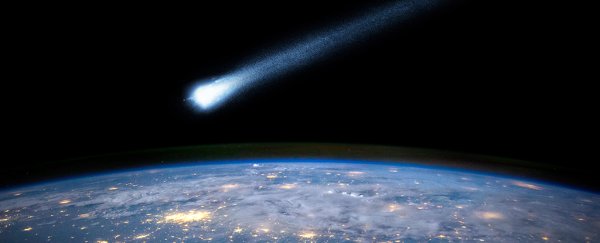Described as a blue and green flash in the sky, a massively bright meteor that passed over the UK in the early hours of Thursday has set a new record as the largest meteor ever sighted by the UK Meteor Observation Network (UKMON).
Nicknamed the St Patrick's Day Meteor, it was first spotted by UKMON at 3.16am on March 17 - St Patrick's Day in the UK and many other parts of the world - and momentarily overloaded the station's camera with light because of its exceptional brightness.
While we're not sure exactly how big the space rock is or where it landed, but UKMON said that "preliminary calculations" suggested its brightness was around -7 on the magnitude scale, which is somewhere between a full moon and a crescent moon on the astronomical magnitude scale.
Roughly one in 1,200 observed meteors appear brighter than -5 mag (the Sun is -26 mag) according to the International Meteor Organisation.
Most are too small to create fireballs that are visible without a telescope, so straight away the St Patrick's Day meteor becomes one of the rarer incidents recorded by astronomers. Experts say it was the presence of magnesium in the meteor that caused the green flame to appear.
As Richard Kacerek, co-founder of UKMON, told Mirror Online: "It was actually two explosions from the same meteor – a smaller one and the larger one – [which] signals that the final one potentially has a fragment surviving and falling to Earth."
Video caught from #London #sky tonight #Battersea @LBC pic.twitter.com/evfnLqHQ9i
— Paul Gilbert 🎧 (@PaulGilbertDj) March 17, 2016
Kacerek confirmed that the meteor was the largest one ever spotted by the UKMON, which was set up in 2012 to use CCTV to track celestial activity.
And that investment has definitely paid off: eight of UKMON's cameras caught the St Patrick's Day Meteor moving through the sky, and you can check out the footage on the organisation's website.
Until now, the biggest meteor-fuelled fireball seen in the skies of the UK is thought to be one spotted passing overhead in 2014, which was also captured on the network managed by UKMON.
It's difficult to assess the size of meteors as they burn up in Earth's atmosphere, but usually very little of the rock survives to make it down to the ground. As far as we know, the largest surviving meteorite fragment on Earth is the Hoba meteorite, estimated to have a mass of around 60 tonnes (that's, say, 10 African elephants).
